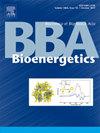PsbA1或PsbA3光系统II D1/S264V突变对QB、非血红素铁和相关氢键网络的差异影响
IF 2.7
2区 生物学
Q2 BIOCHEMISTRY & MOLECULAR BIOLOGY
引用次数: 0
摘要
研究了D1/S264残基及其环境在光系统II受体侧质子耦合电子转移反应中的作用。为此,D1/S264V突变体在嗜热蓝藻长热聚球菌中构建,D1为PsbA1或PsbA3。利用EPR光谱、热释光、(时间分辨)吸收变化测量和血氧测定对PSII突变体进行了研究。虽然突变对PsbA1-PSII的影响较小,但PsbA3-PSII的S264V突变具有显著的影响:i)热释光数据显示QA -到QB的电子转移效率低下;ii) QA -的再氧化减慢了至少10倍;iii)除草剂抑制O2的弱演化;iv)暗适应型PSII未检测到Fe2+QB−EPR信号;相反,v)存在一个大的Fe3+信号,vi)改变了EPR性质;vii)闪光灯照射198 K后,没有观察到QA−Fe2+QB−双自由基信号,证实了QB−的低效形成;viii)与PsbA3-PSII相比,没有质子摄取和非血红素铁还原发生,或者速率非常慢;ix)注意到与QA -形成相关的电致变色反应的变化;x)增加单线态氧的产量,无论是否使用除草剂。PsbA3-PSII的S264V突变导致QA - QB和QAQB -态之间的能隙显著减小。本文从PsbA1-PSII与PsbA3-PSII的不同之处讨论了上述影响与磺基喹啉二酰基甘油、水分子和氢键网络有关。本文章由计算机程序翻译,如有差异,请以英文原文为准。
Differential effects of the D1/S264V mutation in photosystem II with either PsbA1 or PsbA3 on QB, non-heme Iron, and the associated hydrogen-bond network
The role of the D1/S264 residue and the role of its environment in the proton-coupled electron transfer reaction on the acceptor side of Photosystem II were investigated. To this end, D1/S264V mutants were constructed in the thermophilic cyanobacterium Thermosynechococcus elongatus, with D1 being either PsbA1 or PsbA3. The PSII mutants were investigated using EPR spectroscopy, thermoluminescence, (time-resolved) absorption changes measurements, and oximetry. While the mutation had minor effects in PsbA1-PSII, the S264V mutation in PsbA3-PSII had significant consequences: i) thermoluminescence data show inefficient electron transfer from QA− to QB; ii) re-oxidation of QA− was slowed, by at least a factor of 10; iii) the herbicides inhibit weakly O2 evolution; iv) no Fe2+QB− EPR signal was detected in dark-adapted PSII; instead, v) a large Fe3+ signal was present with vi) modified EPR properties; vii) no QA−Fe2+QB− biradical signal was observed after illumination at 198 K following a flash illumination, confirming the inefficient formation of QB−; viii) either no proton uptake coupled to non-heme iron reduction occurred or with a very slow rate compared to PsbA3-PSII; ix) changes were noted in the electrochromic response associated with QA− formation; and x) increased production of singlet oxygen, both with and without herbicides. The S264V mutation in PsbA3-PSII leads to a significant decrease in the energy gap between the QA−QB and QAQB− states. The effects listed above are discussed regarding the differences between PsbA1-PSII and PsbA3-PSII as those related to the sulfoquinovosyldiacylglycerol, the water molecules and the H-bond network.
求助全文
通过发布文献求助,成功后即可免费获取论文全文。
去求助
来源期刊

Biochimica et Biophysica Acta-Bioenergetics
生物-生化与分子生物学
CiteScore
9.50
自引率
7.00%
发文量
363
审稿时长
92 days
期刊介绍:
BBA Bioenergetics covers the area of biological membranes involved in energy transfer and conversion. In particular, it focuses on the structures obtained by X-ray crystallography and other approaches, and molecular mechanisms of the components of photosynthesis, mitochondrial and bacterial respiration, oxidative phosphorylation, motility and transport. It spans applications of structural biology, molecular modeling, spectroscopy and biophysics in these systems, through bioenergetic aspects of mitochondrial biology including biomedicine aspects of energy metabolism in mitochondrial disorders, neurodegenerative diseases like Parkinson''s and Alzheimer''s, aging, diabetes and even cancer.
 求助内容:
求助内容: 应助结果提醒方式:
应助结果提醒方式:


